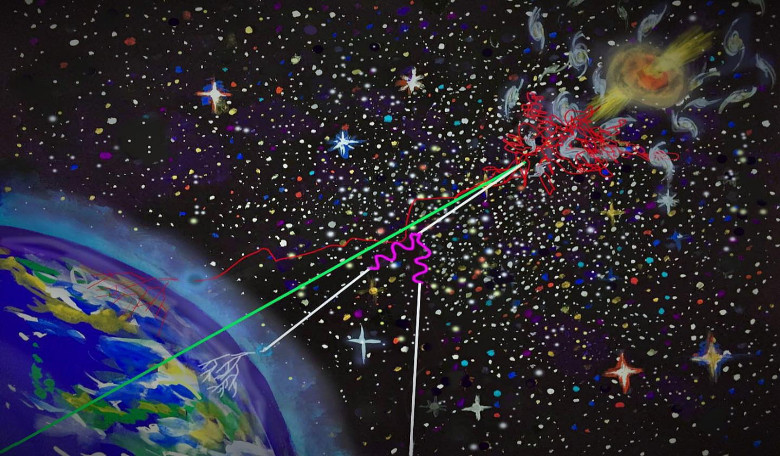Scientists who have been studying one of the biggest mysteries in astroparticle physics - where do very high-energy neutrinos, ultrahigh-energy cosmic rays, and high-energy gamma rays all come from, now think that all three high-energy phenomena could have a common origin; powerful jets from supermassive black holes.
Using an astrophysical model – the first of its kind to be based on detailed numerical computations – a team from Penn State and University of Maryland believe they have an answer to how all three types of "cosmic messenger" particles are produced.
"Our model shows a way to understand why these three types of cosmic messenger particles have a surprisingly similar amount of power input into the universe, despite the fact that they are observed by space-based and ground-based detectors over ten orders of magnitude in individual particle energy," said Kohta Murase, assistant professor of physics and astronomy and astrophysics at Penn State.
"The fact that the measured intensities of very high-energy neutrinos, ultrahigh-energy cosmic rays, and high-energy gamma rays are roughly comparable tempted us to wonder if these extremely energetic particles have some physical connections,” added Murase.
And indeed it appears as though they do. The new model suggests that high-energy gamma rays and very high-energy neutrinos are naturally produced via collisions when cosmic rays are accelerated by energetic jets from supermassive black holes, that afterwards escape through the radio lobes that are often found at the end of the jets. These daughter particles thus inherit the same energy budget of their parent particles.
Ultrahigh-energy cosmic rays are the most energetic particles in the universe; even the Large Hadron Collider, the most powerful particle accelerator in the world, cannot replicate or recreate the high energy associated with these atomic nuclei.
Similarly, gamma rays, which have the highest-known electromagnetic energy, have been observed by the Fermi Gamma-ray Space Telescope and other ground-based observatories to have energies more than a billion times higher than a photon of visible light.
Neutrinos on the other hand are mysterious, neutral subatomic particles that rarely interacts with normal matter. Nonetheless, very high-energy neutrinos, with energy more than one million mega-electronvolts, have been detected in the IceCube neutrino observatory in Antarctica.
The high-energy jets that the cosmic rays shoot from at almost the speed of light, are associated with "active galactic nuclei" – the super-radiating core region around a central supermassive black hole. Most galaxies contain at least one, and sometimes several, super-massive black holes at their centre, and when matter falls into the accretion disks around these black holes, the release of the gravitational energy of the infalling matter produces an active nucleus.
"Our work demonstrates that the ultrahigh-energy cosmic rays escaping from active galactic nuclei and their environments such as galaxy clusters and groups can explain the ultrahigh-energy cosmic-ray spectrum and composition. It also can account for some of the unexplained phenomena discovered by ground-based experiments," said Ke Fang, a postdoctoral associate at the University of Maryland, and first author of the research paper recently submitted to Nature Physics.
"Simultaneously, the very high-energy neutrino spectrum above one hundred million mega-electronvolts can be explained by particle collisions between cosmic rays and the gas in galaxy clusters and groups. Also, the associated gamma-ray emission coming from the galaxy clusters and intergalactic space matches the unexplained part of the diffuse high-energy gamma-ray background that is not associated with one particular type of active galactic nucleus."
Although the data paves a positive way forward in establishing a grand-unified model of how all three phenomena are physically connected to each other by the same class of astrophysical sources, other mechanisms of high-energy neutrino and gamma-ray production still need to be investigated to rule out (or confirm) their origin.
Just how robust this model actually is will shortly be determined when observations with the next-generation neutrino detectors such as IceCube-Gen2 and KM3Net, and the next-generation gamma-ray telescope, Cherenkov Telescope Array begin.











